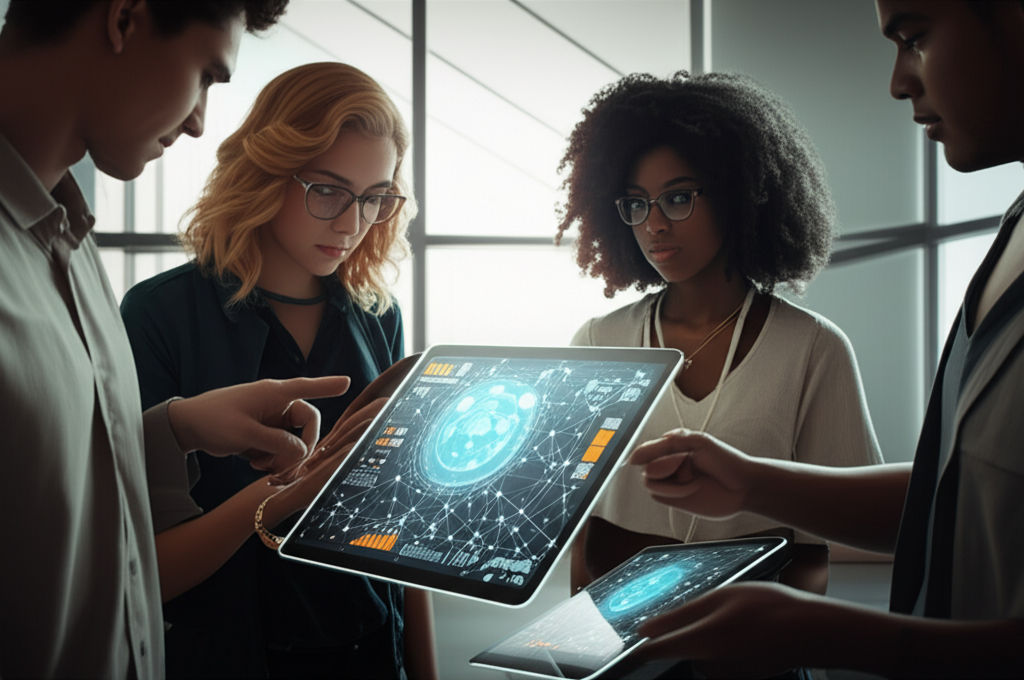Hybrid Learning Rise: Blending Online & Offline
Emily Willis

Photo: Hybrid Learning Rise: Blending Online & Offline
The world of education is constantly evolving, and one of the most exciting shifts we're seeing is the rise of hybrid learning. Gone are the days when learning was strictly confined to a physical classroom or entirely online. Today, a dynamic blend of both is creating richer, more flexible, and highly personalized educational experiences for everyone, from K-12 students to lifelong learners. But what exactly is hybrid learning, and why is it becoming such a game-changer? Let's dive in and explore this fascinating educational trend.
What is Hybrid Learning, Really?
At its core, hybrid learning is an innovative educational model that seamlessly integrates face-to-face classroom instruction with online learning activities. Think of it as getting the best of both worlds: the tangible benefits of in-person interaction combined with the flexibility and accessibility of digital education. Unlike purely online courses that rely solely on digital tools, or traditional in-person classes, hybrid learning creates a balanced approach where students might attend some classes physically and join others virtually from home.
It's important to differentiate hybrid learning from "blended learning," though the terms are often used interchangeably. While both combine online and in-person elements, hybrid learning typically involves simultaneous instruction where some students are physically present while others join remotely, often in real-time. Blended learning, on the other hand, might integrate online exercises and resources within a traditional course to enhance it, without necessarily having simultaneous in-person and remote participation for the same live session. Hybrid learning, with its emphasis on synchronous (real-time) and asynchronous (self-paced) components, offers a unique dynamic that caters to diverse learning preferences and busy schedules.
Why the Sudden Surge in Hybrid Learning?
The concept of blending online and offline learning isn't entirely new, but its widespread adoption has certainly accelerated in recent years. What's driving this significant shift in the educational landscape?
- The Pandemic's Push: The COVID-19 pandemic undeniably acted as a catalyst, forcing educational institutions worldwide to rapidly adapt to remote learning. As the world adjusted, many discovered the inherent value in flexible learning models, paving the way for hybrid approaches to become a crucial framework for the future.
- Technological Advancements: The continuous evolution of educational technology (EdTech) has made hybrid learning more feasible and effective than ever before. Powerful learning management systems (LMS), video conferencing tools, and collaborative digital platforms now enable seamless interaction and resource sharing between in-person and remote participants.
- Demand for Flexibility: Modern life is busy! Students, whether they are working professionals, parents, or those with unique schedules, increasingly seek flexible education options that allow them to balance their studies with other commitments. Hybrid learning addresses this need by removing some geographic and scheduling barriers.
- Personalized Learning Experiences: Every student learns differently. Hybrid models empower educators to craft more individualized learning experiences, allowing students to engage with content at their own pace and through various modalities.
The Benefits of Blending: A Win-Win for All
The rise of hybrid learning isn't just a trend; it's a testament to its numerous advantages for students, educators, and institutions alike.
For Students: More Control, Deeper Engagement
- Unmatched Flexibility: This is perhaps the most celebrated benefit. Students can choose to attend classes in person or remotely, making education more accessible for those with health concerns, travel commitments, or busy personal lives. This flexibility extends to how and when they engage with learning materials, fostering a better study-personal life balance.
- Personalized Learning Paths: Hybrid models allow for a truly student-centered approach. Online components often include self-paced modules, recorded lectures, and digital materials that students can revisit as needed, reinforcing understanding and catering to diverse learning styles.
- Enhanced Engagement and Interaction: While some might worry about isolation in online settings, a well-designed hybrid program can actually boost engagement. In-person sessions can be dedicated to interactive discussions, group work, and hands-on activities, while online platforms facilitate asynchronous discussions and deeper dives into content. The blend creates a more engaging and interactive experience, helping sustain attention and interest.
- Development of Future-Ready Skills: Navigating a hybrid environment naturally builds crucial 21st-century skills like digital literacy, self-discipline, time management, critical thinking, and problem-solving. Students learn to be more autonomous and responsible for their own learning.
- Increased Access to Resources: Digital platforms provide easy access to a wealth of resources and materials, from rewatchable lectures to supplementary readings, enabling students to deepen their understanding at any time.
For Educators: Innovative Teaching, Broader Reach
- Differentiated Instruction: Hybrid learning allows teachers to tailor lessons to each student's skill level and learning style more effectively. By utilizing both in-person and online modalities, educators can offer varied instructional strategies and resources.
- Efficient Use of Classroom Time: With some content delivered online asynchronously, valuable in-person time can be optimized for collaborative learning, discussions, and activities that truly benefit from face-to-face interaction.
- Broader Reach and Inclusivity: Institutions can reach a wider student population, including those who might not otherwise be able to attend traditional on-campus programs due to geographic limitations or other barriers. This promotes greater inclusivity in education.
- Professional Development: Embracing hybrid teaching encourages educators to innovate, explore new pedagogical tools, and develop advanced digital teaching skills, which are invaluable in today's rapidly changing educational landscape.
Navigating the Hybrid Landscape: Challenges and Solutions
While hybrid learning offers a wealth of opportunities, it's not without its hurdles. Successfully blending online and offline elements requires careful planning and proactive solutions.
Common Challenges:
- Technological Infrastructure and Access: A significant challenge is ensuring equitable access to reliable internet connectivity and necessary devices for all students. The "digital divide" can hinder participation and create disparities in the learning experience.
- Teacher Training and Preparedness: Many educators, accustomed to traditional classroom settings, may need substantial training to effectively design and deliver engaging hybrid courses. This includes mastering digital tools, managing simultaneous in-person and remote students, and adapting curriculum.
- Student Engagement and Motivation: Keeping all students engaged, especially those joining remotely, can be tricky. Distractions at home, a sense of isolation, or a perception that online work is less important can impact motivation.
- Time Management and Self-Discipline: Hybrid learning demands a higher degree of self-discipline and time management from students. Procrastination can be magnified when online work piles up, and the lack of a consistent daily routine can be challenging for some.
- Curriculum Adaptation and Assessment: Simply porting traditional lessons online often doesn't work. Curriculum needs to be thoughtfully redesigned to leverage the strengths of both modalities, and assessment methods must be fair and effective for both in-person and remote learners.
- Maintaining a Unified Community: Creating a sense of "one class" where both in-person and remote students feel connected and valued can be challenging. It's easy for an "us vs. them" mentality to emerge.
Practical Solutions:
- Invest in Equitable Technology: Educational institutions, often with government and private sector collaboration, must prioritize providing devices and ensuring stable internet access for all students. Libraries and community centers can offer accessible tech hubs.
- Comprehensive Teacher Professional Development: Offer robust training programs, workshops, and ongoing support for educators. Focus on hybrid pedagogy, effective use of digital tools, and strategies for fostering engagement across both modalities.
- Foster Active Engagement: Design interactive online activities, encourage peer-to-peer collaboration, and facilitate virtual discussions. For synchronous sessions, use tools that allow remote students to participate actively (e.g., polls, breakout rooms). Regularly check in with all learners to gather feedback.
- Promote Strong Routines and Resources: Provide clear, consistent access to routines, resources, and assignment information through a well-organized LMS. Encourage students to establish a dedicated study space and a regular work routine to manage their time effectively.
- Rethink Curriculum and Assessment: Develop new materials tailored for hybrid delivery. Utilize strategies like the "flipped classroom" model, where students review content online before class, freeing up in-person time for application and discussion. Design assessments that can be administered equitably to both in-person and online groups.
- Build a Strong Community: Actively promote a unified class culture. Use icebreaker activities that include all learners, assign collaborative projects that bridge the physical and virtual divide, and establish clear communication channels. Acknowledge and greet both in-person and remote students at the start of sessions.
Making Hybrid Learning Work for You
Whether you're a student, an educator, or a parent, here are some actionable tips to thrive in a hybrid learning environment:
For Students:
- Be Proactive: Don't wait until the last minute! Start on online coursework early in the week.
- Create a Dedicated Study Space: Designate a quiet, distraction-free area for
Latest ✨
View AllInfrastructure: more than a cost, it's a catalyst! Discover how vital investments fuel economic growth, create jobs, and build a prosperous future.
Emily Willis
Innovation is vital for future business success. Learn why a robust strategy ensures survival, growth, and competitiveness in a changing world.
Emily Willis
Effective time management is crucial for success in all areas of life. By mastering time management, you can boost productivity, reduce stress, and achieve a healthier work-life balance. This guide explores practical tips and techniques to help you take control of your schedule, enhance focus, and maximize your potential.
Emily Willis
The stock market is a crucial component of the global economy, providing a platform for capital formation, investment, and wealth creation. Understanding stock market movements, including bull and bear markets, market volatility, and factors influencing stock prices, is essential for investors, businesses, and policymakers. Economic, financial, and behavioral factors all play a role in shaping stock market dynamics.
Emily Willis
Business
View All
August 5, 2024
How to Save and Invest to Achieve Your Financial GoalsSaving and investing are essential components of building financial security. Saving helps accumulate money for short-term goals, while investing allows money to grow for long-term aspirations. Understanding financial goals, developing effective savings strategies, and creating a customized investment plan are key steps in achieving financial success.
Emily Willis

June 9, 2025
Customer Retention Strategies That WorkUnlock lasting success! Learn proven customer retention strategies to build loyalty, reduce churn, and boost your business growth.
Emily Willis

June 8, 2025
Market Research: Your Business CompassMarket research: your ultimate business compass. Gain vital insights on customers, competitors & trends to steer your business to growth & success.
Emily Willis
Economy
View AllUnlock business success! Learn producer behavior: optimize costs, boost revenue, and master strategies for profit maximization and market dominance.
Read MoreNavigate economic shifts. Learn what a recession is, spot key indicators, and get actionable strategies for personal finance and business resilience.
Read MoreUnpack GNP: Understand national wealth & global economic contributions. Learn how GNP differs from GDP & why it matters for a country's prosperity.
Read MoreEntertainment
View All
August 4, 2024
Social Media's Influence on Celebrity Culture: Trends and ImpactsSocial media has revolutionized celebrity culture by enabling direct fan engagement, promoting authenticity, and creating new trends such as influencer marketing and digital content creation.
Emily Willis

August 4, 2024
Recommended Movies and TV Series to Watch This Yearlist of recommended movies and TV series to watch this year. The movies include "Dune: Part Two," "Spider-Man: No Way Home," "The French Dispatch," "No Time to Die," and "Encanto." The TV series include "Stranger Things: Season 4," "The Mandalorian: Season 3," "The Witcher: Season 2," "Ted Lasso: Season 3," and "Loki: Season 2." Each entry includes reasons to watch, such as stellar cast, visually stunning cinematography, engaging plot, and character development.
Emily Willis

August 4, 2024
Profiles of Famous Artists Who Inspire the Younger Generationthe inspirational aspects of famous artists such as Vincent van Gogh, Frida Kahlo, Pablo Picasso, Banksy, Yayoi Kusama, Jean-Michel Basquiat, Georgia O'Keeffe, Andy Warhol, Kehinde Wiley, and Ai Weiwei. It highlights their perseverance, innovation, authenticity, social commentary, mental health advocacy, and representation, among other qualities, and how these aspects continue to inspire young artists to pursue their creative dreams.
Emily Willis
Health
View AllRegular physical activity is crucial for maintaining long-term health and well-being. It has numerous benefits, including improving cardiovascular health, aiding in weight management, enhancing mental health, strengthening bones, boosting immune function, and promoting longevity.
Emily Willis
sleep for physical and mental well-being, discussing the benefits of sleep such as physical restoration, brain function, emotional regulation, concentration, and reduced risk of chronic diseases. It explains the different stages of the sleep cycle and provides guidelines for how much sleep individuals of different ages need.
Emily Willis
A healthy lifestyle is crucial for enhancing overall quality of life in today's fast-paced world. It involves habits such as a nutritious diet, regular exercise, adequate sleep, stress management, and avoiding harmful substances. Benefits include improved physical health, enhanced mental well-being, increased energy levels, better sleep quality, and longevity. Implementing healthy habits gradually, staying consistent, seeking support, and monitoring progress are key steps towards a healthier lifestyle. Prioritizing a healthy lifestyle is not just about adding years to life but about adding life to years, leading to a more fulfilling and vibrant life.
Emily Willis
Trending 🔥
View All
1
2
3
4
5
6
7
8
10
Lifestyle


Sports
View AllAugust 5, 2024
Sports for Social Good: Promoting Diversity, Inclusion, and Community Engagement
Read MoreTechnology
View All
August 4, 2024
Latest Trends in Mobile Application Development
latest trends in mobile application development for 2024. These trends include the integration of 5G technology, artificial intelligence and machine learning, Internet of Things (IoT), augmented reality (AR) and virtual reality (VR), cross-platform development, mobile wallets and payment gateways, progressive web apps (PWAs), enhanced app security, voice search and integration, and sustainability and green mobile apps.

August 5, 2024
How AI is Used to Solve Problems in Various Industries
Artificial Intelligence (AI) is reshaping industries across the globe, from healthcare to finance, by solving complex problems, increasing efficiency, and driving innovation. In healthcare, AI is saving lives through drug discovery, disease diagnosis, personalized medicine, and virtual health assistants.

August 4, 2024
Impact of Artificial Intelligence on Business Operations: Efficiency and Innovation
Artificial Intelligence (AI) is transforming modern business operations by increasing efficiency, driving innovation, and driving strategic decision-making. AI automates routine tasks, improves data analysis, and enables personalized customer experiences.

August 5, 2024
Benefits of Using Cloud Computing for Your Business
Cloud computing has revolutionized business operations by offering cost savings, scalability, improved collaboration, enhanced security, and robust disaster recovery. It allows businesses to access services over the internet, reducing the need for physical infrastructure and providing flexibility.



















